What, did you think face-stretching and skin-piercing were modern fads? Not by a long shot! People have been undergoing painful procedure to modify their bodies (and their looks) for thousands, maybe even hundreds of thousands, of years.
Lip Stretching
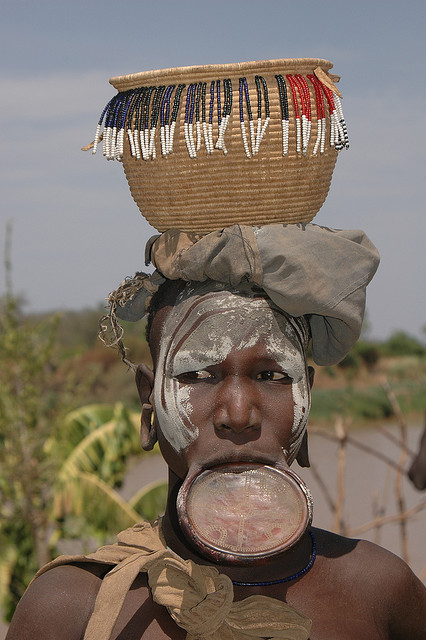 (Image credit: Flickr user Rita Willaert)
(Image credit: Flickr user Rita Willaert)
Lip stretching is a body modification that goes back
10,000 years and had been practiced all over the world, from Siberia to South America, from the Middle East to Europe, although there is no evidence that the custom traveled from one area to another. The procedure survives only in Africa and among some Amazonian tribes in South America. The practice is seen among women in the
Mursi and Surma tribes of Ethiopia. The lower lip is pierced and a peg is inserted, to be replaced with a larger peg as the skin stretches. A plate or labret is inserted when the piercing is large enough. Traditionally, this is done as a young woman prepares to marry, but is now a personal decision rather than an obligation.
Skull Binding
 (Image credit: Wikipedia user Robrrb)
(Image credit: Wikipedia user Robrrb)
Skull binding has been practiced at various points in history in widespread parts of the world, with some evidence of Neanderthal skulls that had been shaped around 45,000 BCE in Iraq. The custom of head shaping has been most notable among skulls excavated in Peru, where the practice dates back 9,000 years. The skull can only be shaped
during infancy. The bones eventually harden to the point that skull modification would only break the cranial bones. An infant's skull would be wrapped with cloth (sometimes with wooden boards added) to restrict its expansion sideways, causing the head to grow long and tall instead. This practice was usually restricted to the wealthier classes. Reproductions of such skulls can be
purchased online.
Scarification
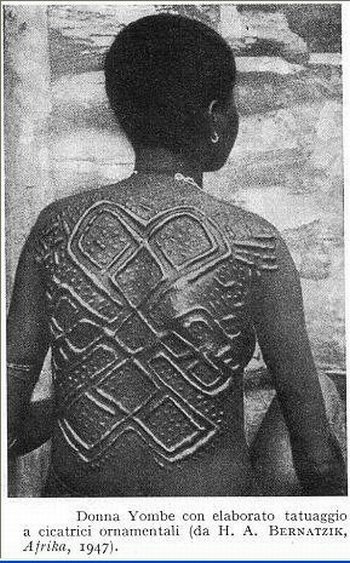
Scarification is a traditional alternative to tattooing in Africa, as ink doesn't stand out well on
dark skin (link contains nudity). There are several purposes to the procedure: to decorate the body, to prove bravery and willingness to bear pain, and to signal allegiance to the tribe and family to which one belongs. The practice goes back at least several hundred years among widely scattered tribes. In some tribes, the process of scarification is part of a rite of passage into adulthood at puberty. See
more pictures of scarification in Africa (contains nudity).
Neck Accentuation
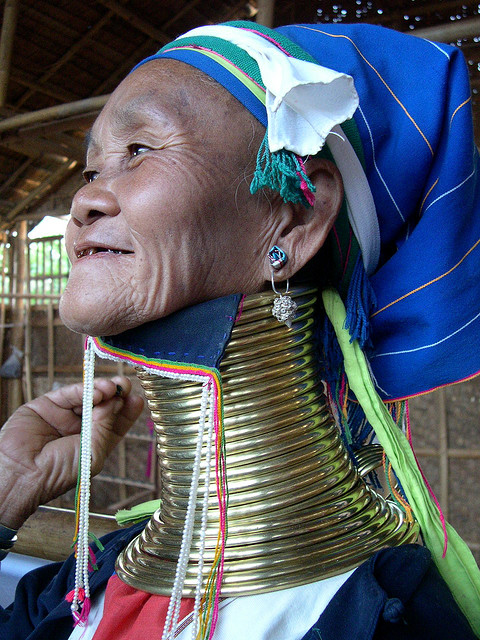 (Image credit: Flickr user florathexplora)
(Image credit: Flickr user florathexplora)
The women of the
Kayan Lahwi tribe of the mountainous region straddling Burma and Thailand undergo a body modification that causes their necks to appear extremely long. Starting at the age of five,
brass coils are set around their necks. These are replaced with longer coils as the girl ages, until a woman is carrying around about ten pounds of brass. This process does
not elongate the neck; rather, it reshapes the collar bone and presses the shoulders down, which creates the illusion of a long neck.
Tattoo
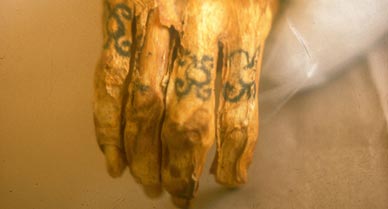 (Image credit: Joann Fletcher)
(Image credit: Joann Fletcher)
No one knows how old the practice of tattooing the skin is, but it is thought to go back at least
7,000 years in Japan. Egyptian
mummies four thousand years old were discovered with skin tattoos. In Europe, the practice is quite old as well. Ötzi the Iceman, a well-preserved European frozen European who died 5300 years ago was tattooed with
57 dots and lines on his spine and legs, which may be related to the arthritis he suffered.
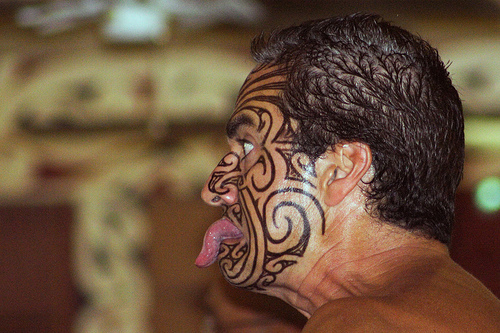 (Image credit: Flickr user The Life of Bryan)
(Image credit: Flickr user The Life of Bryan)
The word tattoo comes from the Polynesian word tatu. Western explorers first encountered the custom in Tahiti in the 1700s. The traditional
Maori moko facial tattoos were already a part of tribal culture when the Maori left Polynesia and settled in New Zealand over 700 years ago.
Circumcision
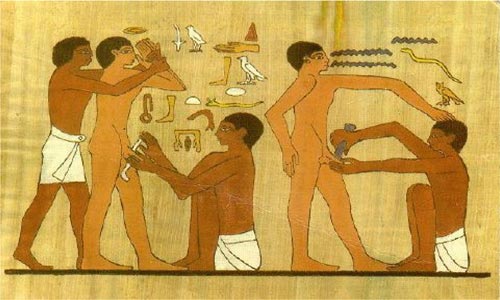
Circumcision is an ancient bodymod that goes back further than recorded history. Some scholars believe
it began in eastern Africa, long before Abraham made it a ritual of faith. It may possibly have been used to
dampen sexual desire and pleasure. The practice spread to Egypt and the Middle East over time. In males, circumcision entails the removal of the foreskin from the penis, which can affect sexual pleasure, but does not destroy it. However, some cultures also practice "female circumcision", which is actually
genital mutilation, as it involves removal of the clitoris. This is done to prevent
any sexual pleasure, and therefore prevent a woman from straying from her husband. The practice can lead to lifelong pain, sexual dysfunction, problems in childbirth, infection, and even death.
Foot Binding
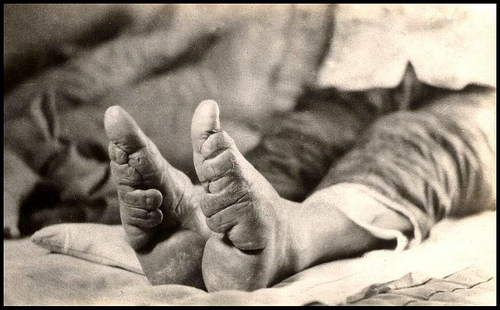 (Image by Flickr user Okinawa Soba)
(Image by Flickr user Okinawa Soba)
Foot binding in China lasted for about a thousand years, until the 20th century when the practice was outlawed. The reason most often given is that small feet were sexually alluring. Why would crippled, deformed feet make a woman more attractive? The underlying reason is that a woman with bound feet is a status symbol, an indicator of wealth and social standing. Only a man of considerable means could afford to have a wife, concubine, or daughters who couldn't work. Read more about foot binding in
a previous Neatorama post.
 (Image credit: Flickr user Rita Willaert)
(Image credit: Flickr user Rita Willaert) (Image credit: Wikipedia user Robrrb)
(Image credit: Wikipedia user Robrrb)
 (Image credit: Flickr user florathexplora)
(Image credit: Flickr user florathexplora) (Image credit: Joann Fletcher)
(Image credit: Joann Fletcher) (Image credit: Flickr user The Life of Bryan)
(Image credit: Flickr user The Life of Bryan)
 (Image by Flickr user Okinawa Soba)
(Image by Flickr user Okinawa Soba)





How can cutting her genitals NOT result in negative consequences? The male genital is exterior and mono-task and what is done is minimal and does not impede function. Female genitalia is multi-task and interior to the body, for the most part, and function is usually problematic for the rest of their lives. The girl/woman is forever scarred, unlike in male circumcision, as the ritual performed on females is rarely done with any semblance of concern for the victims' well-being and body image after the fact or for hygiene during the act.
I don't doubt that women who have never known anything BUT mutilation might well encourage the ritual but you will never convince me that performing it on young women, who are old enough to understand that pain is about to be forced on them, is anything less than cruel.
It's a perfect example of our subjective standards of beauty really are, and also how societies that privilege men will always find ways to repress women. It's telling that so many of the modifications done to women are done from an early age, when consent is really not something they can give. It's hard to be "aware" or social pressure, too, since it acts on you from the moment you're born. That raises interesting issues of consent in its own way.
I'm not suggesting that women who do elect to undergo FGM (I am aware that there are women who do this, since their lives are made more difficult socially if they don't) don't have agency. They do. They have rational reasons for undergoing the procedure. But it is still risky and often damaging. It's the result of a society that provides few opportunities for women (girls have it done to them/elect to do it to find husbands, and the women who perform the procedure are usually elderly widows using improvised tools).
I know it sounds unfair for Westerners to judge the practice, but it is by and large done to young girls who can't consent, and that should be universally frowned upon. Of course, simply banning the practice causes it to become less safe. The real solution is expanding opportunities to women where the procedure(s) are common-such as in Egypt, where up to 96% of girls and women have their genitals cut in some way or another.
"A five-year study of 300 women and 100 men in Sudan found that 'sexual desire, pleasure, and orgasm are experienced by the majority ['nearly 90%'] of women who have been subjected to this extreme sexual mutilation, in spite of their being culturally bound to hide these experiences."
http://www.informaworld.com/smpp/content~db=all?content=10.1080/00224498909551521
There are several cases of voluntary female circumcision btw. One of the leading activists against female circumcision actually ran away from home in order to be circumcised, because her parents were against it.
There are also several cases of forced male circumcision, and I'm not just talking about doing it to babies, who are unable to defend themselves.
There is no fundamental difference between cutting parts off female genitals and cutting parts off male genitals. Anyone that sees such a difference just happens to live in a culture where one is practiced and not the other.
91 young men died last year of male circumcision is just one province of South Africa btw, and there were also several amputations and partial amputations. The death toll this year is up to 44 already despite having been slowed down by the World cup:
http://www.mg.co.za/article/2009-07-14-eastern-cape-circumcision-death-toll-rises-to-44
Are you aware that the USA also used to practise female circumcision? Fortunately, it never caught on the same way as male circumcision, but there are middle-aged white US American women walking round today with no external clitoris because it was removed. Some of them don't even realise what has been done to them. There are frequent references to the practice in medical literature up until at least 1959. Most of them point out the similarity with male circumcision, and suggest that it should be performed for the same reasons. Blue Cross/Blue Shield had a code for clitoridectomy till 1977.
One victim wrote a book about it:
Robinett, Patricia (2006). "The rape of innocence: One woman's story of female genital mutilation in the USA."
Nowadays, it's illegal even to make an incision on a girl's genitals though, even if no tissue is removed. Why don't boys get the same protection?
Don't get me wrong. I'm totally against female circumcision, and I probably spend a lot more time and money trying to stop it than most people. If people are serious about stopping female circumcision though, they also have to be against male circumcision. Even if you see a fundamental difference, the people that cut girls don't (and they get furious if you call it "mutilation"). There are intelligent, educated, articulate women who will passionately defend it, and as well as using the exact same reasons that are used to defend male circumcision in the US, they will also point to male circumcision itself (as well as labiaplasty and breast operations), as evidence of western hypocrisy regarding female circumcision. The sooner boys are protected from genital mutilation in the west, the sooner those peoples that practice FGM will interpret western objections as something more than cultural imperialism.
Everyone, male or female, should have the right to decide for themselves whether or not they have parts cut of their genitals. It's *their* body.